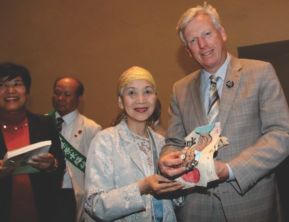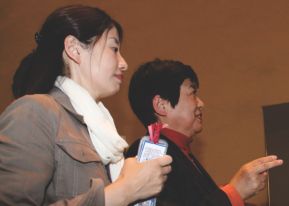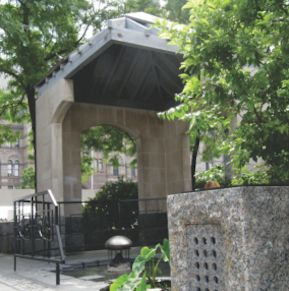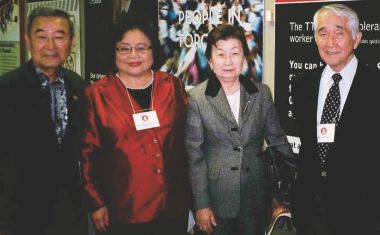
Hiroshima Day 2010 Archive

Toronto Mayor David Miller Welcomes Japanese Peace Activists
May 5, 2010 Article by Anton Wagner
Toronto Mayor David Miller welcomed over fifty Japanese peace activists at the public forum, “Working Together for a World Without Nuclear Weapons,” in the Toronto City Hall Council Chamber on May 5
The event, organized by the Hiroshima Day Coalition, brought together Canadian peace activists and members of Gensuikyo, the Japan Council Against Atomic and Hydrogen Bombs, who had attended the opening of the Nuclear Non-Proliferation Treaty Review Conference at the United Nations in New York City.
After welcoming the forum participants at the City Hall Peace Garden, Mayor Miller opened the proceedings in the City Council Chamber by declaring that he was proud to be a member of the international Mayors for Peace organization. “I would like to tell our friends from Japan that our people from Toronto stand in solidarity with all the mayors around the world who are fighting so hard to eradicate nuclear weapons from our world and to end the tragedies that happened in Hiroshima and Nagasaki.”
Mayor Miller noted the significance of the nearly seven million signatures in support of the abolition of nuclear weapons gathered by the Japanese peace movement and stated that Torontonians were honoured by the presence of the Japanese peace activists in the City Council Chamber. “Toronto is a city that has people from every country of the world. Hundreds of thousands of Torontonians have fled war or have family members who have come from war-torn countries. War is an ever present memory in Toronto. It’s an ever present value of Torontonians that we must strive for peace.”
Setsuko Thurlow of the Hiroshima Day Coalition then introduced three speakers from the Japan Council Against Atomic and Hydrogen Bombs.
Mr. Kunio Nakano, director of Shizuoka Prefecture Gensuikyo, spoke about the efforts by the 240,000 hibakusha living in Japan and their supporters to bring about the abolition of nuclear weapons. 1,600 members of Gensuikyo flew to New York to attend the NPT Review Conference and delivered the nearly seven million signatures gathered by the organization. He referred to the 1997 Ottawa Conference that led to the Anti-Personnel Landmines Treaty and expressed the hope that the NPT Review Conferences would lead to a similar outlawing of nuclear arms. “Nuclear weapons should not exist. No one on earth should suffer from nuclear weapons as hibakusha ever again.”
Shiro Kawamoto described his own experiences as an eight-year old when the atom bomb was dropped on Hiroshima and how the American hydrogen bomb test at Bikini Atoll in 1954, one hundred times more powerful than the bomb dropped on Hiroshima, led to the anti-nuclear bomb movement in Japan. He stated that with the thousands of nuclear weapons still in existence today, “our peace is threatened wherever we are in the world.”

Suganuma Mikio spoke about protests against the continued pervasive impact on Japanese lives of the 134 U.S. military bases in Japan resulting from the 1951 Japan-U.S. Security Treaty. 75% of these bases are concentrated in Okinawa where the “relocation” of the U.S. Marine Corps Futenma Air Station in Ginowan City has become a major national political issue.
These presentations were followed by Canadian peace activists who informed their Japanese guests about ways in which Canadians worked for peace and nuclear disarmament. Anton Wagner, from the Hiroshima Day Coalition, explained why the Peace Garden was built at the entrance to City Hall in 1984. 78% of Torontonians who voted in the 1982 municipal election voted to support nuclear disarmament.
In 1983 Toronto City Council officially designated Toronto a Nuclear Weapons-Free Zone and became a member of the Mayors for Peace movement initiated by the cities of Hiroshima and Nagasaki. The City Council then voted to build the Peace Garden on Nathan Phillips Square in 1984 as “a lasting physical expression of our highest aspirations in our most public place,” noting that “in symbolizing peace and a love for mankind, it will represent our continuing struggle to avoid the devastation of war.”

Dr. Barbara Birkett, representing Physicians for Global Survival, spoke about working for peace with a public health perspective and described the physicians’ participation in the International Campaign to Abolish Nuclear Weapons.
Shirley Farlinger, from the Canadian Voice of Women for Peace, reviewed her organization’s 50-year long work for the elimination of nuclear weapons and for the elimination of war itself. She also recalled the role played by Canadian scientists and by the Canadian government in supplying the uranium used in the first atom bombs.
Bruce Mutch, a former Anglican minister in Japan from Veterans Against Nuclear Arms, addressed the forum in Japanese and described the various ways his veterans organization organized and lobbied the Canadian government to be a more active supporter of nuclear weapons abolition.
Metta Spencer, editor of Peace Magazine, reviewed the progress that has been made towards nuclear disarmament since she organized a public forum led by disarmament experts in the Toronto City Hall Council Chamber in November of 2009 see http://zeronuclearweapons.com.
Rob Acheson, from the Canadian Department of Peace Initiative, described the efforts by his organization to convince the Canadian government to establish a cabinet-level Department of Peace that would have nuclear weapons abolition as one of its main goals.
Helen Chilas, from Peace Day Canada, concluded the presentations by describing her efforts to empower youth, students and artists to become involved in the effort to achieve world peace.
After questions and discussion, the public forum called on Toronto City Council and on City Councils of cities around the world to increase their participation in Mayors for Peace and to join actively in the global effort to abolish nuclear weapons. The forum also called on the Government of Canada and on the Government of Japan to endorse and support negotiations for a United Nations Convention on the Abolition of Nuclear Weapons, as proposed by the United Nations Secretary-General.
In addition to the Toronto Hiroshima Day Coalition and the Japan Council Against Atomic and Hydrogen Bombs, this official appeal was endorsed by an unprecedented number of Canadian peace and environmental organizations.
These included Science for Peace, Veterans Against Nuclear Arms, Physicians for Global Survival, the Canadian Voice of Women for Peace, the Canadian Department of Peace Initiative, World Without Wars and Violence, Uranium Free Kootenay Boundary, the Toronto Coalition to Stop the War, the Toronto Area Interfaith Council, the Canadian Peace Alliance, Greenpeace Canada, Peace Day Canada, Peace Magazine and Greenspiration.
The co-chairs of the public forum were Phyllis Creighton of Science for Peace and Setsuko Thurlow of the Hiroshima Day Coalition. Simultaneous translation was provided by Fumiko Kataoka.
This August 6, the Hiroshima Day Coalition is organizing the 65th commemoration of the atomic bombings of Hiroshima and Nagasaki at the Toronto City Hall Peace Garden. The main speaker will be MP Bob Rae, the Liberal Party of Canada Foreign Affairs Critic.
_Article also posted on the Hiroshima Peace Media Center.
Join the Campaign Now!
Millions have endorsed the Hiroshima Day Coalition May 5th “Call for Solidarity & Action” on the abolition of nuclear weapons. Read the text here
August 4-6th. A-Bombing Survivors Artwork. Toronto Limited Engagement. Details.
List of Hiroshima / Nagasaki Day events across Canada. 14 in total! Click here for the list
Contact the Hiroshima Day Coalition
A-Bombing Survivors – Setusko Thurlow and Joe Ohori

L to R. Sid Ikeda (Japanese Canadian Cultural Center / HDC Committee Member), Setsuko Thurlow (Hiroshima A-Bombing Survivor, Member of the Order of Canada), Mrs. Joe Ohori, Joe Ohori (Hiroshima A-Bombing Survivor).
Setsuko Thurlow, Hiroshima A-Bombing Survivor
“My beloved city of 360,000, close to ninety percent of whom were women, children and the elderly, suddenly and totally became desolation, heaps of ashes and rubble, skeletons and blackened corpses. By the end of 1945, approximately 140,000 had perished.”
Order of Canada Citation for Setsuko Thurlow, C.M., Toronto, Ontario on October 26th 2007: “As a 13-year old schoolgirl, Setsuko Thurlow found herself in close proximity to the hypocentre of the atomic blast that rocked Hiroshima. A survivor of one of the most pivotal events in modern history, she displayed great courage and leadership, sharing her experiences in order to sensitize us to the consequences of armed conflict on civilian populations and to promote lasting peace.”
After relocating to Toronto, she joined forces with the mayors of Toronto, Hiroshima and Nagasaki to establish the Peace Garden in Nathan Phillips Square. Over the years, she has served with a number of organizations, including Voices of Women, the Canadian Council of Churches and the Campaign for Nuclear Disarmament, continuing her journey from victim to activist.
Joe Ohori, Hiroshima A-Bombing Survivor
“We didn’t know what happened. It seemed like oil was spattered and a fire was lit, and we jumped into the fire.”
“I was born in Vancouver, BC in 1931. At the age of 9, I was sent to Hiroshima to receive Japanese language education. After 5 years living in Hiroshima, I was hit by A-Bomb at Hiroshima Station, 2 km away from the A-bomb blast. I suffered from severe burn on the left side of my face and hand. Managed to walk home located in southern part of the city but found it completely burned down. Spent a night and escaped from the city the next day and I was ridden till the end of September. After 60 years, for the first time, I talked about my experience in public.”
Millions Sign Appeal for a Nuclear Weapon-Free World
Presented at the United Nations during the 2010 NPT Conference
Total number of Signatures Collected reaches 6,912,802
May 4, 2010 — Japan Council against Atomic & Hydrogen Bombs
The “Appeal for a nuclear weapon-free world to the 2010 NPT Review Conference” was proposed jointly by all delegates to the 2008 World Conference against Atomic and Hydrogen Bombs in Hiroshima, and the signature drive in support of the “Appeal” has developed as grassroots movements everywhere in Japan and many other cities in the world.
The total number of the signatures collected reached 6,912,802 by May 3, 2010. Most of them were carried to New York City by more than 1,500 members of our delegation, and to our honor, were presented to you and UN High Representative Sergio Duarte on May 2, 2010 at the Dag Hammarskjold Plaza. The campaign is continuing until May 28, 2010 with the goal of 12 million signatures. /More..)
Press release
City of Toronto Proclaims August 6th, 2010 Hiroshima Day -- Evening Commemorations, Nathan Phillips Square
TORONTO / CNW / – On August 6th, Hiroshima Day Peace Commemorations will be held at the Toronto Peace Garden, Nathan Phillips Square, marking the 65th Anniversary of the 1945 Hiroshima and Nagasaki atomic bombings.
“Hiroshima Day is an important opportunity for us all to re-commit ourselves to the cause of nuclear disarmament. The growing number of international actors with the power to unleash destruction should be a call to action: to reduce, and ultimately to eliminate, nuclear arms in the world,” states Bob Rae, Liberal Party Foreign Affairs Critic, the keynote speaker in Toronto.
“Hundreds from across Toronto and as far away as Ottawa are expected to attend on Friday August 6th to demand an end to all nuclear weapons around the world and to say farewell to our Peace Garden in its current location, due to the revitalization of Nathan Phillips Square,” says Dr. Anton Wagner, member of the City of Toronto Peace Garden Public Advisory Group and event organizer.
Hiroshima Day Coalition email.